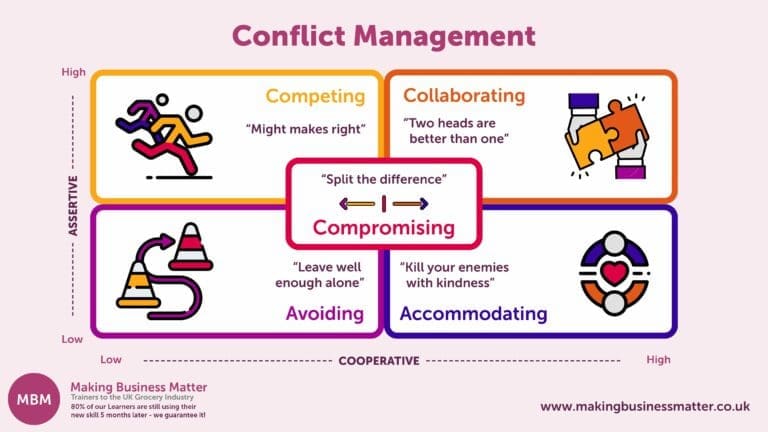4 Conflict Management Activities to Get Your Team Pulling Together and Not Away
I feel a story is the best way to convey the subject at hand in articles of this nature. So here we go…
I stared down a kid at school because my teacher said it would ‘help resolve our issue’. Sounds Ludacris, right? Yes, it’s true.
I’m in the playground at Primary school becoming involved in an issue between myself and another child. Nothing major, just classic playground verbals between a couple of 10-year-olds. Normal stuff. On this occasion, however, a particular teacher (who must have been having a bad day) decided to take us aside into the staff room. Now, this is how you know it was serious.
The staff room was an unknown land in which we believed there may have been a portal to the 4th dimension… or a doorway to Narnia… or something. Anyway, we were led through this familiar doorway into a very unfamiliar place. The teacher sat us both down and told us she had a method of resolving issues of this nature. For the life of me, I cannot remember what the issue between me and this kid actually was. But, I’ll remember the teacher’s ridiculous ‘resolution’ to the problem for as long as I live… irony.
She explained that, in order to become civil again, we must engage in a staring contest until one of us fails. The method in her madness was to get us to look at each other. The incentive was supposed to be victory, which is what made us want to follow along with this plan.
As 10-year-olds, we didn’t want to so much as breathe in each other’s general direction after an argument in the playground. If you squint hard enough, stand on one leg and tilt your head to the side – you can sort of see where she was coming from. If we had to face each other, we promptly bounce back and forget the conflict. Farfetched. I know.

So, Did it Work?
Absolutely not. Of course not. It was never going to work in a million years. Looking back, I think she knew this.
Whilst the incentive was there to get us to do it, the very same incentive meant that once I won the staring contest, I gloated my victory and made matters significantly worse. I was ten, what else would you expect? Yes, it worked for a split second. Staring at each other made us laugh a little bit which lightened the mood. If this was the expected outcome, she was right. It was a gamble, however. She was relying on the conflict between us being surface enough to forget about once we started laughing at each other.
This, of course, was not the case. She had failed to consider that this was not the first time conflict had arisen between me and him. We both yearned for the victory.
This is a prime example of how not to resolve conflict. Why start a conflict management article with a story how about not to do it? Because Thomas Edison knew 1000 methods that don’t make a lightbulb, before finding the one that did. Don’t worry, there are not 1000 ways not to resolve conflict in this article. Just the one.
How do You Actually do Conflict Management, Then?
Click the image below for a higher resolution.

Well, workplace conflict is a fickle mistress. She can take countless forms, sizes, and shapes. Sometimes, staff members can work out problems quietly between themselves. If this is you, fantastic! You’re making the workplace better for everyone. Other times, however, it is necessary for a senior member of staff to become involved in the resolution of the conflict. In this case, there are some conflict management activities you can engineer to create a space for settlement. Dive into a world of conflict management activities below.
Conflict Management Activities
1. The Four Word Game
This game is a great one for getting large groups together. Even if there is a specific problem between specific members of staff, getting the whole team involved is great. This will avoid isolating employees in their conflict and will also work as a preventative training measure for the rest of your team. A win-win!
The specific objective of this game is to get staff members working through differing opinions. Here’s the method:
Firstly, Hand a pen and paper to each team member and ask them to write four words on it. They all must associate with the word ‘conflict’.
Secondly, pair up your team members. Ask them to decide between them the best four words out of the eight they have written between them. Each pair should move forward with four final words for their pair, discarding the other four.
Finally, pair each pair with another pair and ask them to do the same. Pick four of their eight words as a group, discard four and move forward with the rest. Continue this process – teams of 4 pair up with other teams of 4 and so on. Always moving forward with only four words. This should eventually result in half the room negotiating with the other half of the room. They’re looking to find the ultimate four words that associate with ‘conflict’.
Finish by Debriefing the Team
Ask them what techniques they feel were at use, how they resolved disagreements on the words. Ask them each ‘what’s one thing you learned during this exercise?’ This direct, yet open question forces each team member to really think about their top takeaway from the exercise. This will help them remember it and hopefully use it of their own accord in future.
2. Beach Ball Pass

This activity is fantastic for getting teams to work together and devise a plan between them in order to reach a goal. Ultimately, this is what we want as managers and team leaders instead of conflict arising between employees.
For this one, you’ll need to go out a purchase yourself a shiny new inflatable beach ball… or something similar. Better yet, dig the old one out from the back of your shed and pray it hasn’t got a tear in it.
Firstly, divide your group into two teams. Teams of 5 or above work best for this.
Secondly, Have them stand across from each other and hit a beach ball into the centre.
Beforehand, explain to the teams that they must hit the ball twice as many times as there are members in each team. Teams of 6? Each team must hit the ball 12 times. The catch here is that no single member can hit the ball twice in a row. The first team to reach the magic 12 hits wins.
Give each team time before the game to devise a plan of how they will reach this number first. The winning team must explain their plan to the losing team and have them understand why this was the better way to do it. This gets both teams involved in working together towards solving problems and reaching a goal.
Continuing on, give the team their next challenge. Each team member can only hit the ball once. This time, however, they must reach the goal number of hits as a whole team, rather than as two competing teams. Now, this creates the space for the teams to build on the strengths of the winning plan, and utilise the weaknesses of the losing plan.
This avoids the gloating victory that was talked about in my teacher’s not-so-effective staring contest. Letting one team walk away with victory will likely result in further conflict.
Finish by Debriefing your Team
Ask them why the winning plan worked. Ask them why they chose the plan for the final challenge, and why that worked too. This will make the team reflect on plans they devised together and why that created success for them in the end.
Always finish with the magic question; ‘What’s one thing you learned from this exercise?’. Ask this to each member individually, again, to promote the use of these techniques in the future.
3. Mr. Mime

Conflicts often arise due to acting or passing judgement based on inaccurate assumptions. To improve this, we need healthier dialogue in the workplace.
This game is great for nailing questioning and clarification skills. Learning healthy dialogue is paramount in the workplace for avoiding conflict in the future, and the process of learning this can help manage conflict as it’s happening.
Firstly, have everyone find a partner in the room. Either standing or sitting is fine for this. Instruct the group by explaining that they must label themselves A and B.
Secondly, continue by explaining that person A must ask questions to person B. These questions ought to be relatively simple for the sake of keeping the game moving. Person B must answer these questions charade-style. Mime the answer until person A correctly guesses it.
Examples:
- 1. ‘What do you do in your spare time?’
- 2. ‘What is your favourite film?’
- 3. ‘What are your plans for the weekend?’
The rule is that person A is entitled to as many clarification questions as they like. Person B can only nod or shake in response before continuing.
After correctly guessing a set number of questions, switch roles.
This game really pushes staff members to work through the point one person is trying to get across. Giving both members a chance to do this will elevate empathy and understanding for your whole team.
Of Course, Finish by Debriefing your Team
Ask them what they learned, why certain things worked, why others did not. The purpose of debriefing these activities is to both reflect on the task and to equip staff members with tools to prevent conflict among themselves.
4. If it’s Before ‘But’, it’s BS!

This is quite a famous concept. Analysing the psychology of dialogue shows that when people use ‘but’ in a sentence it, more often than not’ acts as a dismissal of the first part of the sentence.
‘I do appreciate the work you’re doing… but -‘
We know straight away that anything after that is a complete contradiction and that the prefix was simply to come across nicer than the actual words they’re saying. This is necessary, sometimes… politeness should not be disregarded. Using ‘but’ constantly, however, weakens your argument. Conveying a point with this technique shows someone immediately that you don’t agree and want to steer the subject into your perspective or opinion.
Firstly, split the team into pairs and have them label themselves A and B once again.
Secondly, pick a topic that is reasonably controversial. Such as; ‘people should be able to work flexible hours as long as they get the work done on time’. Share the topic with the group.
Thirdly, explain to the group that each pair has 5 minutes to win the argument. Choose ‘for’ or ‘against’ for each pair’s A and B member. They do not have the choice in who’s who.
Lastly, allow the 5 minute debates to take place. Listen as conflict naturally arises.
To continue the activity, repeat the process once again. This time, however, explain to the team that they must undertake another 5 minutes (choose a new topic if you choose) without ever saying the word ‘but’. Let the 5 minutes commence and watch as each member works at building more solidified arguments. Debates will be much more balanced between speaking and listening.
Finish by Debriefing your Team, Again
What made your debates better the second time around? Why is this?
Always, always, always finish with the magic question to each member individually. This is the difference between training that sticks and training that does not.

The Better Way to Conflict Management Activities
These four conflict management activities are all things that will get your whole team involved. You can manage current conflict, prevent future conflict and train your team in healthier workplace attitudes all at the same time.
If my teacher had used conflict management activities similar to one of these to resolve my conflict with the other student, things would have been much smoother. I wouldn’t have gloated about my victory and made matters worse and we wouldn’t have utterly despised each other for the rest of the year.
Sometimes managers must get involved in conflict to resolve it, this is natural. Conflict will arise in the workplace, every workplace. No matter if you’re sitting at any old desk or roller-skating into meetings at Google HQ, conflict happens. The struggle is not to banish conflict altogether but to prevent and manage conflict in the appropriate manner as much as possible.
Strive to listen rather than speak, to be open rather than closed, to be curious rather than judgemental. Want more? Check out our ultimate guide on Conflict Resolution Skills.




